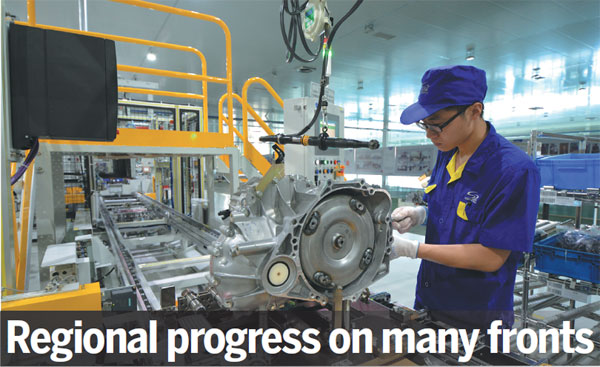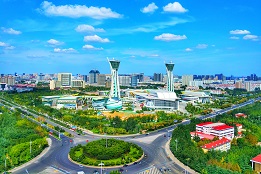Regional progress on many fronts
Business development boosts growth in surrounding area
High-tech industry clusters in the Weifang High-Tech Industrial Development Zone play crucial roles in supporting regional development in Weifang.
The national-level economic development zone, established in 1991, has been recognized as a national independent innovation demonstration zone, a national independent innovation technology park and an intellectual property rights protection pilot zone.
"The zone is looking to develop locally featured industries to strengthen its core competitiveness. Some emerging businesses have demonstrated strong growth potential," said Chu Baojie, Weifang's director of communications and Party chief of the zone's Working Committee.
Chu said the zone has developed several nationally or even globally leading industry clusters to strengthen its core competitiveness.
There are 10 national-level and 17 provincial-level industrial bases to support the zone's modern industry development. The zone has established five pillar industries, namely vehicle and equipment manufacturing, acoustics and optoelectronics, biotechnology, software information and new materials, according to Chu.
So far, the zone has attracted 115 high-tech companies and 21 provincial-level or above innovation-driven companies.
In 2015, high-tech industries contributed 67 percent to the zone's overall production value.
The zone is home to more than 50 vehicle parts developers, including Weichai Group, Foton Shandong Multifunction Plant and Shengrui Transmission. A complete auto industrial chain, which can support China's high-end vessels and the development of its automotive industry, has been established, according to Chu.
Foton's internet automotive industrial base was launched in March this year. The base will be capable of producing 700,000 engines annually upon completion. By 2025, the base will be able to supply 2.3 million units of vehicles totaling 280 billion yuan ($42 billion).
The zone also has an optoelectronic industrial cluster with more than 200 companies. Companies including GoerTek and Shandong Inspur Huaguang Optoelectronic reported a total income of 22 billion yuan in 2015. The total optoelectronic industrial output value of the cluster will reach 100 billion yuan by 2020.
Biopharmaceutical and software industries are expected to report 10 billion yuan and 20 billion yuan of overall revenue, respectively, by 2020.
"Innovation capacity is the key to supporting the zone's development, and innovation platforms are the foundations on which to support innovation capacity enhancement," said Song Chifeng, the zone's deputy Party chief and director of the zone's administrative committee.
An innovation-supporting platform named Blue Wisdom Valley was launched in the zone last year. The valley has three incubators: Yanyuan High-Tech Park, supported by Peking University; the Chinese Academy of Sciences (Weifang) Innovation Park; and Tuspark Innovation Park supported by the Tsinghua University Science Park.
The zone also launched the InnoSpring Incubator in Silicon Valley, and partnered with Rice University's Richard E. Smalley Institute for Nanoscale Science and Technology and the Houston Technology Center to support innovation.
The zone also partnered with over 150 research institutions and universities to develop innovation platforms. There are four national technology business incubators and three provincial incubators in the region.
The premium innovation environment strongly supports business growth in the zone. Shengrui Transmission claimed that they have developed the first front-engine, front-drive, hybrid and plugin 8AT in the world.
"We have development platforms in five cities in three countries. It is a product developed with global intelligence," said Liu Xiangwu, chairman of the board of Shengrui.
Companies in the zone have established over 30 overseas research and development centers to introduce more foreign technologies to China.
"The first-class R&D platform and top talents will help the zone to develop more new projects and industries," Chu said.
Increasing numbers of companies are seeking business opportunities aboard, aimed at supporting long-term growth goals.
Weichai acquired French engine maker Moteurs Baudouin in 2009. It also acquired a 25 percent stake in German forklift maker Kion Group in 2012, which announced plans to acquire US logistics company Dematic for $2.1 billion in July.
GoerTek's products are sold in Japan, South Korea, Europe and North America.
More than 100 companies in the zone are selling their products in overseas markets. The zone's total import and export revenue last year was $2.2 billion, a year-on-year increase of 29 percent. Companies have launched more than 100 offices, marketing centers and R&D centers abroad. A total of 771 international trademarks have been registered by companies in the zone.

A technician with Shengrui Transmission assembles an 8AT, the company's signature product.




